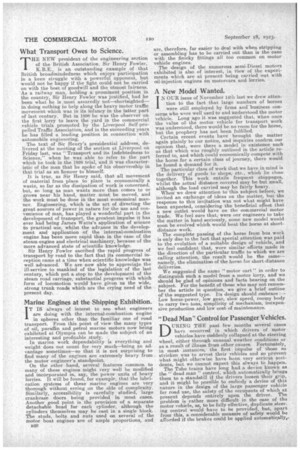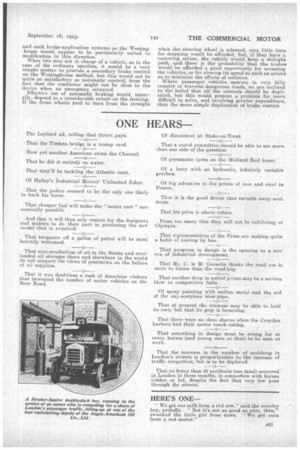The Attitude of the Workers Towards Efficiency in Driving.
Page 1

Page 2

Page 3

If you've noticed an error in this article please click here to report it so we can fix it.
HE IDEA prevails amongst transport workers— or, rather, that numerically important section of them who form the Transport Workers' Union–that a strong effort should be made to secure greater efficiency in vehicle driving by the institution of a scheme of tests of capability and of licences.
If such a scheme had as its only object the improvement of driving efficiency, there would be no ground for disagreement about it, but it will be necessary for the Motor Transport Employers' Federation to look extremely closely into the matter in all its bearings before giving support to it. It must not be made the means for limiting the number of workers, or for forcing men unwillingly into the Union, or for depriving non-members of all chances of being offered jobs. Nor must the possession of certificates of competency be used as a lever for demanding higher wages, for the tendency is for an increased wage ultimately to become the standard wage for good, bad or indifferent workers.
However, we shall be very interested to learn what arguments can be put forward in favour of the institution of driving tests, and to know if it is claimed that such tests would eliminate the driver whose judgment of time, speed and distance was defective. Some years ago we dealt fully with this subject, and initiated the phrase "road sense" as covering the ability to judge time, speed and distance, and the capacity for anticipating the doings of other road users and foreshadowing contingencies. " Road sense" seems to have passed into very general use just lately, and it is an attribute the possession of which might not always be disclosed under examina tion.
The awards at somg of the provincial parades of
the Commercial Motor Users Association instituted in 1906, and the competitions of the London Safety First Council recently established, are doing a great deal amongst the drivers of goods vehicles and public psissenaer-carrying vehicles to encourage careful driving. It is quiet work, but none the less effective for that. Many owners and users encourage their drivers fo enter for these competitions, and, moreover, enter into the spirit of the movement, thus actively demonstrating to their employees the importance which they
attach to freedom from accident. We would like to see a great deal more being done in this direction ; when business improves, loads areanere numerous and freight rates more remunerative, we shall look for great developments along this line.
THE NEW president of the engineering section of the British Association, Sir Henry Fowler, K.B.E., is an outstanding example of that British broadmindedness which enjoys participation in a keen struggle with a, powerful opponent, but would not be happy if the fight could not be carried on with the best of goodwill and the utmost fairness. As a railway man, holding a prominent position in
H the country, Sir enry Fowler Was justified, had he been what he is most assuredly not—shortsighted in doing nothing to help along the heavy motor traffic movement which was in its infancy in the latter part of last century. But in 1898 he was the observer on the first lorry to leave the yard in the commercial vehicle trials promoted by the Liverpool Self-propelled Traffic Association, and in the succeeding years he has filled a leading position in connection with automobile engineering. The text of Si' Henry's presidential address, delivered at the meeting of the section at Liverpool on Friday last, was "Transport and its Indebtedness to Science," when he was able to refer to the part which he took in the 1898 trial, and it was characteristic of the man that he spoke of his observership in that.trial as an honour to himself.
It is true, as Sir Henry said, that all movement of material from place to place is economically a waste, so far as the dissipation of work is concerned, but, so long as man wants more than comes to or grows near his hand, matter must be moved, and the work must be done in the most economical man ner. Engineering, which is the art of directing the great sources of power in nature for the use and con venience of man, has played a wonderful part in the development of transport, the greatest impulse it has ever had being James Watts's application of science to practical use, whilst the advance in the developanent and application of the internal-combustion engine has been more rapid than in the case of the steam-engine and electrical machinery, because of the more advanced state of scientific knowledge. Sir Henry Fowler ascribed the rapid progress of transport by road to the fact that its commercial in ception came at a time when scientific knowledge was well advanced. We are now able to appreciate the ill-service to mankind of the legislation of the last century, which put a stop to the development of the steam road carriage, substantial progress with which form of locomotion would have given us the wide, strong trunk roads which are the crying need of the present day.
Marine Engines at the Shipping Exhibition.
IT IS always of interst to see what engineers are doing with the internal-combustion engine in spheres other than the familiar one of road transport. From this point of view the many types of oil, paraffin and petrol marine motors now being exhibited at Olympia can be made the subject of an interesting and profitable study.
In marine work dependability is everything and weight does not count for very much—being an advantage sometimes—so that it is not surprising to find many of the engines are extremely heavy from the motor engineer's standpoint.
On the other hand, several features common to many of these engines might very well be modified and incorporated in, say, the power units of heavy. lorries. It will be found, for example, that the lubrication systems of these marine engines are very thorough without erring on the side of complexity. Similarly, accessibility is carefully studied, large crankcase doors being provided in most eases. Another good point is the provision of a separate detachable head for each cylinder, although the cylinders themselves may be east in a single block. The studs, bolts and nuts used on several of the motor boat enginesare of ample proportions, and
B20 are, therefore, far easier to deal with when stripping or assembling has to be carried out than is the case with the finicky fittings all too common on motor vehicle engines. The design of the numerous semi-Diesel motors exhibited is also of interest, in View of the experiments which are at present being carried out with oil-injection engines on motorcars and lorries.
A New Model Wanted.
IN OUR issue of November 14th last we drew attention tO the fact that large numbers of horses were still employed by firms and business concerns who were well used to and understood the motor vehicle. Long ago it was suggested that, when once the value of the motor vehicle for transport work was understood, there would be no room for the horse, but the prophecy has not been fulfilled.
Certain recent events have brought the matter again plainly to our notice, and inquiries confirm our opinion that, were there a model in existence such as that which was roughly outlined in the article referred to, and which could eooriontically compete with the horse for a certain class of journey, there would be found a demand for it,
The particular class of work that we have in mind is the delivery of goods to shops, etc., whichlie close together. This work entails frequent stoppages, whilst the actual distance covered may be but small, although the load carried may be fairly heavy.
When we drew attention to this subject before, we invited an exchange of ideas on the matter, but the response to this invitation was not what might have been expected, considering the beneficial effect that a new outlet would have on the commercial motor trade. We feel sure that, were our engineers to take the matter in hand seriously, some new model would soon be evolved which would beat the horse at shortdistance work.
The complete passing of the horse from bus work is only due to the fact that special attention was paid to the evolution of a suitable design of vehicle, and we feel confident that, were similar efforts made in the direction of the particular traffic to which we are calling attention, the result would be the same— namely, the elimination of the horse for short-distance deliveries.
We suggested the name " motor cart 7 in order to distinguish such a model from a motor lorry, and we should be glad of opinions and facts bearing on the subject. For the benefit of those who may not remember the article in question, we give a brief outline of the suggested type. Its design should embrace :— Low horse-power, low gear, slow speed, roomy body to carry two tons, simplicity of mechanism, inexpensive production and low cost of maintenance.
"Dead Man" Control for Passenger Vehicles.
DURING THE past few months several eases have occurred in which drivers of motor vehicles have suddenly collapsed at the steering wheel, either through unusual weather conditions or as a result of illness from other causes. Fortunately, in most instances, the first impulse of those so stricken was to arrest their vehicles and so prevent what might otherwise have been very serious accidents, but we cannot expect this always to happen. The Tube trains have long hada device known as the "dead man" control, which automatically brings them to a standstill if the drivers loosen-their grip, a,nd it might he possible to embody a device of this nature in the 'design of the large passenger vehicle for road use, the safety of the occupants of which at present depends entirely upon the driver. The problem is rather more difficult in the ease of tho motor vehicle, as, to be fully effective, duplicate steering control would have to be provided, but, apart from this, a considerable measure of eafety would be afforded if the brakes could be applied automatically,
and such brake-application systems as the Westinghouse would appear to be particularly suited to modification in this direction.
When two men are in charge of a vehicle, as in the case of the ordinary 'omnibus, it would be a very simple matter to provide a secondary brake control on the Westinghouse method, but this would not be quite so satisfactory as automatic control, from the feet that the conductor might not be close to the device when an emergency occurred. Effective use of automatic braking would, naturally, depend to a considerable extent on the steering. If the front wheels tend to turn from the straight
when the steering wheel is released, very little time for stopping would be afforded, but, if they have a 'eastoring action, the vehicle would keep a straight path, •and. there is thel probability that the brakes) would be .afforded a good opportunity for arresting the vehicles; or far slowing its speed to such an extent as to minimize the effects of collision.
Where passenger vehicles operate in very hilly country or traverse dangerous roads, we are inclined to the belief that all the controls should be duplicated, but this would present a problem far more difficult to solve, and involving greater expenditure, than the more simple duplication of brake control.




























